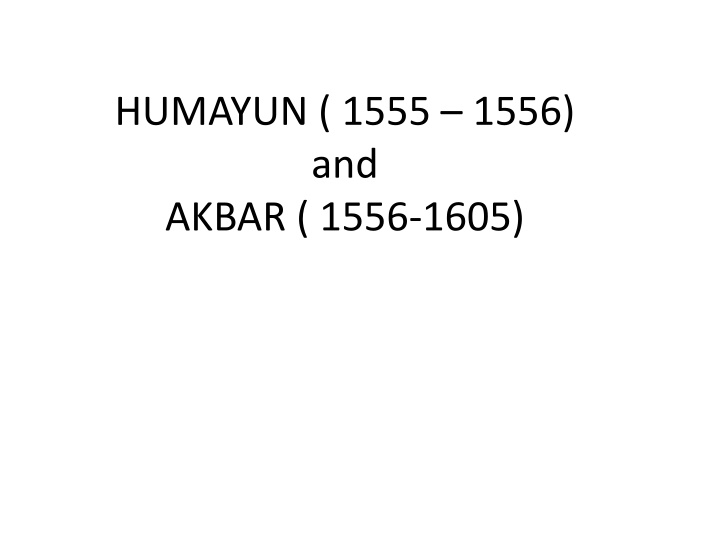The Mughal Emperors Humayun and Akbar: A Legacy of Conquest and Diplomacy
Humayun, though not a skilled general, was kind and learned, while Akbar, one of the greatest monarchs of India, expanded the Mughal Empire through military conquests and strategic alliances with the Rajputs. Akbar's policy of religious tolerance and Rajput integration left a lasting impact on the Mughal dynasty.
Download Presentation

Please find below an Image/Link to download the presentation.
The content on the website is provided AS IS for your information and personal use only. It may not be sold, licensed, or shared on other websites without obtaining consent from the author.If you encounter any issues during the download, it is possible that the publisher has removed the file from their server.
You are allowed to download the files provided on this website for personal or commercial use, subject to the condition that they are used lawfully. All files are the property of their respective owners.
The content on the website is provided AS IS for your information and personal use only. It may not be sold, licensed, or shared on other websites without obtaining consent from the author.
E N D
Presentation Transcript
HUMAYUN ( 1555 1556) and AKBAR ( 1556-1605)
HUMAYUN ( 1555 1556 ) When Humayun left India in 1540 , he married Hamida Banu Begum on his way to Sind , When they stayed in Amorkot , Akbar was born in 1542 . A Hindu ruler Rana Prasad was the ruler of the Kingdom . Humayun defeated his brothers , Kamran and Askari At that time the Sur Dynasty in India was declining rapidly . In 1555 , Humayun defeated the Afghans and recovered the Mughal throne . After Six months , he died in 1556 due to his fall from the staircase of his Library .
Humayun was not a good General and Warrior , he was Kind and Generous . He was also learned and a student of Mathematics, Astronomy and Astrology . He loved painting and wrote poetry in Persian language . AKBAR ( 1556M- 1605) Born on October 15 , 1542 in Amarkot , and enthroned at the age of 14 . He began his Military conquests under the a regent He was one of the greatest monarchs of India . He came to the throne after his father s death . But his positions was dangerous because Delhi was seized by the Afghans . Their commander in Chief , Hemu , was in charge of it .
In the Second Battle of Panipat in 1556 , Hemu was almost on the point of victory . But an arrow pierced his eye and he became unconscious . His army fled and the fortune favoured Akbar . The Mughal got victory During the first years of Akbar s reign , Bairam Khan acted as his regent . He consolidated the Mughal empire . After five years he was removed by Akbar due to court intrigues and sent to Mecca . But on his way Bairam was killed by an Afghan .
He conquered northern India from Agra to Gujarat and than from Agra to Bengal . He strengthened the northwest frontier , Later , he went to the Deccan . Relations with Rajputs His Rajputs policy was notable . He married the Rajput Princess , the daughter of Raja Bharamal . It was a turning point in the history of Mughals . Rajputs served the Mughals for four generations . Many of them rose to the positions of military generals . Raja Bhagawan Das and Raja Man Singh were given senior positions in the administration by Akbar . One by One , all Rajput states submitted to Akbar
But the Ranas Pratap Singh of Mewar continued to defy despite several defeats . In the Battle of Haldighati , Rana Pratap Singh was severely defeated by the Mughal army led by Man Singh in 1576 . Following the defeat of Mewar , most of the leading Rajput rulers had accepted Akbar s Authority . Akbar s Rajput policy was combined with a broad religious toleration . He abolished the pilgrim tax and later the Jiziya . The Rajput policy of Akbar proved to be beneficial to the Mughal state as well as to the Rajputs . The alliance secured to the Mughals the services of the bravest warriors. It ensured peace in Rajasthan and a number of Rajputs who joined the Mughal service rose to important positions .
Religious policy Akbar rose to fame in the pages of history due to his religious policy . Various factors were responsible for his religious ideas . In the beginning of his life , Akbar was a pious Muslim . Soon after marrying Jodh Bai of Amber , he abolished the pilgrim tax and In 1562 , he abolished Jiziya . He allowed his Hindu wives to worship their own gods . Later, he became a skeptical Muslim . In 1575 , he ordered for the construction of Ibadat Khana ( House of Worship ) at his new capital Fatepur Sikri .
Akbar invited learned scholars from all religious like Hinduism , Jainism , Christianity and Zoroastrianism . He disliked the interference of the Muslim Ulemas in political matters . In 1579 , he issued the Infallibility Decree by which he asserted his religious powers . In 1582 , he promulgated a new religion called Din Ilahi or Divine Faith . It believes in one God . It contained good points of all religions . It was based on rational . It upholds no dogma . It was aimed to bring cordial relations among different religious people .
But it was failure one . During his life time , it had only fifteen followers including Birbal . Akbar did not compel anyone to his new faith . Administration of Akbar Provincial Administration The state was divided into Provinces to smoothly run the administration The Provinces were of three categories . 1. Provinces with limited rights -- Imrat I Taufid 2. Provices with unlimited rights -- Imrat I Khassa 3. The Provinces which were captured with strength --- Imrat ul Istisa The highest officer of the province was known as Wali . In the Sultanate and under Sur rulers , they were called Hakims They were given Iqtas
Land Revenue Administration Akbar made some experiments in the land revenue administration with the help of Raja Todar Mal . The land revenue system of Akbar was called Zabti or Bandobast system . It was further improved by Raja Todar Mal . By this system , Todar Mal introduced a uniform system of land measurement . The revenue was fixed on the average yield of land assessed on the basis of past ten years . The land was divided into four categories . 1. Polaj Cultivated every year 2. Parauti Once in two years 3. Chachar Once in three or four years 4. Banjar Once in five or more years The mode of payment was generally in cash
Mansabdari System Akbar introduced the Mansabdari system in his administration . Under this system every officer was assigned a Rank ( Mansab) The lowest rank was 10 and the highest rank was 5000 for the nobles . Princes of royal blood received higher ranks . The ranks were divided into two Zat and Sawar . Zat means personal and it fixed the personal status of a person . Sawar rank indicated the number of cavalrymen of a person who was required to maintain . Every Sawar had to maintain at least two horses . The Mansab rank was not hereditary . All appointments and promotions as well as dismissals were directly made by the emperor .
Jahangir ( 1605 1627 ) When Akbar died , Prince Salim came to power with the title of Jahangir ( Conqueror of World ) in 1605 . His period was witnessed a lot rebellions . His son Khusrau revolted but was defeated and imprisoned . Nur Jahan In 1611 , Jahangir married Mehrunnisa who was known as Nur Jahan ( Light of World ) Her father Itimadud dauala was a respectable person . He was given the post of Chief Diwan . Other members of her family also benefited from this alliance . Nur Jahan s elder brother Asaf Khan was appointed as Khan I Saman, , a post reserved for the nobles .
In 1612 , Asaf Khans daughter , Arjumand Banu Begum ( later known as Mumtaj ), married Jahangir s third son , prince Khurram ( later Shah Jahan ). Nur Jahan formed a group of Junta . And this led to two factions in the Mughal court This drove Shah Jahan into rebellion against his father in 1622 , since he felt that Jahangir was completely under Nur Jahan s influence . however , it is clear that Nur Jahan dominated the royal household and set new fashions based on Persian traditions . She encouraged Persian Art and Culture in the Court . She was a constant companion of Jahangir.
Jaja Jahan revolted against his father . His father ordered him to go to Kandahar . After Jahangir s death in 1627 , Shah Jahan reached Agra with the support of the nobles and the Army . Nur Jahan was given a pension and lived a retired life till her death 18 years later . Shah Jahan ( 1627 1658 ) Shah Jahan launshed a prolonged campaign in the northwest frontier to recover Kabdahar and other ancestral lands . The Mughal army lost more than five thousand lives during the successive invasions between 1639 and 1647 . Then Shah Jahan realized his mistakes and stopped fighting .
His Deccan policy was more successful . He defeated the forces of Ahmadnagar and annexed it. Both Bijapur and Golkonda brought under his control and sogned a treaty . He established four Provinces in the Deccan Khandesh , Berar , Telungana and Daulatabad . They were put under the control of his son Aurangazeb . War of Succession The last years of Shah Jahan s reign were raised a bitter war of succession among his four sons ___ Dara Shikoh ( Crown Prince ) , Shuja ( Governor of Bengal ) Aurangazeb ( Governor of Deccan ) , and Murad Baksh ( Governor of Malwa and Gujarat )
Aurangazeb emerged victorious in this struggle . He entered the Agra Fort after defeating Dara . He forced Shah Jahan to surrender . Shah Jahan was imprisoned in a Fort at Agra . He died in 1666 and buried beside his wife s grave in the Taj Mahal . Aurangazeb ( 1658 1707 ) Aurangazeb was one of the ablest of the Mughal Kings . He assumed the title of Alamgir ___ World Conqueror . His military Campaigns in his first ten years of reign were a great success . He suppressed the minor revolts But he faced serious difficulties in the latter part of his reign .
The Jats and Satnamis and also the Sikhs revolted against him . These revolts were induced by his harsh religious policy . Deccan Policy The Deccan policy of the Mughals started from the reign of Akbar , who conquered Khanesh and Berar . Jahangir fought against Malik Amber of Ahmadnagar . During the Shah Jahan s reign , Aurangazeb , as governor of Deccan , followed an aggressive Deccan Policy . When Aurangazeb , became the Mughal emperor , for the first 25 years , he concentrated on the northwest frontier . At that time , Shivaji , the Maratha ruler , established an independent Maratha Kingdom in the north and south Konkan .
To curtail the spread of the Marathas , Aurangazeb decided to invade Bijapur and Golkonda . He defeated Sikandar Shah of Bijapur and annexed his Kingdom . Then , he proceeded against Golkonda and eliminated the Kutb Shahi dynasty . And annexed it . Religious Policy Aurangazeb was a staunch and orthodox Muslim in his personal life . His aim was to transform India into an Islamic State . He created a separate department to enforce moral codes under a High powered officer called Muhtasib . Drinking was prohibited . Cultivation and drugs were banned .
He forbade music in the Mughal court . He discontinued the Celebration of Dasarah . Royal Astronomers and Astrologers were dismissed from service . Initially , Aurangazeb banned the construction of new Hindu temples and repair of old temples . Then he began a policy of destroying Hindu temples . The celebrated temples at Mathura and Benaras were reduced to ruins . In 1679 , he re imposed Jiziya and Pilgrim tax . He was not tolerant of other Muslim sects . The celebration of Muharram was stopped . He was against the Sikhs and he executed the 9th Sikh Guru Tej Bahadur . This had resulted in the transformation of Sikhs into a warring community .
His religious policy was responsible for turning the Rajputs , the Marathas and Sikhs into the enemies of Mughal empire . Therefore , Aurangzeb was held responsible for the decline of the Mughal empire . Causes for the Downfall of the Mughals . The Mughal Empire declined after the death of Aurangzeb . The nobles in the Mughal Court were divided into number of group . In 1739 Nadir Shah imprisoned Mughal emperor and looted Delhi The Religious policies and Deccan policies of Aurangzeb contributed to its decline . The weak successors and demoralization of the Mughal army also paved the way for it . The Financial difficulties due to continuous wars led to the decline .
The Europeans began to settle in India Further , the Invasion of Nadir Shah and Ahmad Shah Abdali weakened the Mughal empire . Thus the decline and downfall of the Mughal Empire was due to the combination of Political , Social and Economic factors . _________























